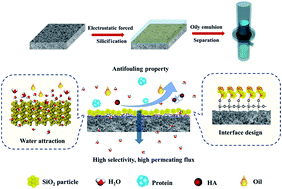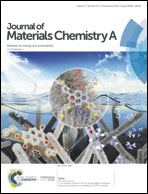An ultrathin in situ silicification layer developed by an electrostatic attraction force strategy for ultrahigh-performance oil–water emulsion separation†
Abstract
Membrane fouling caused by oil or other pollutants is one of the major challenges for membrane separation technology used for emulsified oil/water purification. Aiming at the realization of comprehensive fouling-resistant/fouling-release properties, and the further achievement of long-term cyclic separation, an ultrathin silica (SiO2) layer is conformally engineered onto a porous polyketone (PK) substrate via the electrostatic attraction force silicification process. This in situ silicification forms an ultrathin and superhydrophilic/underwater superoleophobic interface structure that allows the realization of ultrahigh water permeance up to 7533 L m−1 h−1 bar−1, an exceptionally high emulsion flux up to 6000 L m−1 h−1 bar−1 (close to pure water permeance), and a high rejection of >99.9% against various oily emulsions. The unique design of the superhydrophilic silicification layer grown on the hydrophilic PK substrate also endowed the membrane with comprehensive antifouling properties against a broad range of oily emulsions containing various pollutants such as proteins, surfactants, and other natural organic materials (NOM), from which a nearly 100% recovery ratio of permeation flux could be obtained after several cycles of oily emulsion filtration. The use of an inorganic SiO2 modified layer incorporated into a highly chemically inert PK substrate (SiO2-d-PK membrane) also enabled the application of the SiO2-d-PK membrane under more challenging conditions, where its great tolerance and long-term stability toward salty and strongly acidic/alkaline solutions and various organic solvents were further demonstrated. Overall, this study provides an insight into engineering an ultrathin membrane with ultralow fouling-propensity for treating challenging oily emulsions.



 Please wait while we load your content...
Please wait while we load your content...